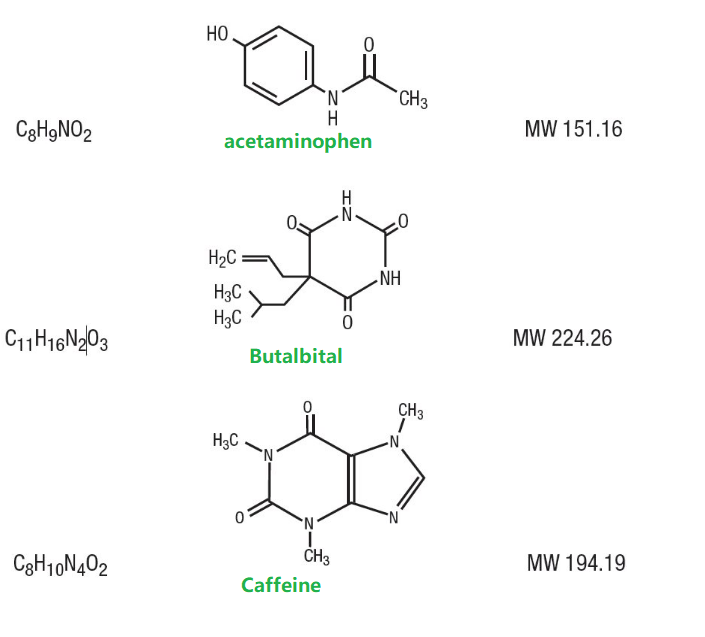Fioricet (Butalbital, Acetaminophen, and Caffeine Tablets, USP) is supplied in tablet form for oral administration.
Each tablet contains the following active ingredients:
butalbital USP . . . . . . . . . .50 mg
acetaminophen USP . . . . 325 mg
caffeine USP . . . . . . . . . . .40 mg
Fioricet contains Butalbital, Acetaminophen, and Caffeine. Acetaminophen is a pain reliever and fever reducer. Butalbital is in a group of drugs called barbiturates. It relaxes muscle contractions involved in a tension headache. Caffeine is a central nervous system stimulant. It relaxes muscle contractions in blood vessels to improve blood flow.
Butalbital
Butalbital is well absorbed from the gastrointestinal tract and is expected to distribute to most tissues in the body. Barbiturates in general may appear in breast milk and readily cross the placental barrier. They are bound to plasma and tissue proteins to a varying degree and binding increases directly as a function of lipid solubility.
Elimination of butalbital is primarily via the kidney (59% to 88% of the dose) as unchanged drug or metabolites. The plasma half-life is about 35 hours. Urinary excretion products include parent drug (about 3.6% of the dose), 5-isobutyl-5-(2, 3-dihydroxypropyl) barbituric acid (about 24% of the dose), 5-allyl-5(3-hydroxy-2-methyl-1-propyl) barbituric acid (about 4.8% of the dose), products with the barbituric acid ring hydrolyzed with excretion of urea (about 14% of the dose), as well as unidentified materials. Of the material excreted in the urine, 32% is conjugated.
The in vitro plasma protein binding of butalbital is 45% over the concentration range of 0.5-20 mcg/mL. This falls within the range of plasma protein binding (20%-45%) reported with other barbiturates such as phenobarbital, pentobarbital, and secobarbital sodium. The plasma-to-blood concentration ratio was almost unity, indicating that there is no preferential distribution of butalbital into either plasma or blood cells.
Acetaminophen
Acetaminophen is rapidly absorbed from the gastrointestinal tract and is distributed throughout most body tissues. The plasma half-life is 1.25 to 3 hours, but may be increased by liver damage and following overdosage. Elimination of acetaminophen is principally by liver metabolism (conjugation) and subsequent renal excretion of metabolites. Approximately 85% of an oral dose appears in the urine within 24 hours of administration, most as the glucuronide conjugate, with small amounts of other conjugates and unchanged drug.
Caffeine
Like most xanthines, caffeine is rapidly absorbed and distributed in all body tissues and fluids, including the CNS, fetal tissues, and breast milk.
Caffeine is cleared through metabolism and excretion in the urine. The plasma half-life is about 3 hours. Hepatic biotransformation prior to excretion results in about equal amounts of 1-methylxanthine and 1-methyluric acid. Of the 70% of the dose that is recovered in the urine, only 3% is unchanged drug.
Fioricet Mechanism of Action
Fioricet is a brand name consisting of a combination of butalbital (a barbiturate), APAP and caffeine which is indicated for the treatment of tension headaches, muscle contraction headaches and post-dural puncture headaches. Acetaminophen is a pain reliever and fever reducer. Butalbital is in a group of drugs called barbiturates. It relaxes muscle contractions involved in a tension headache. Caffeine is a central nervous system stimulant. It relaxes muscle contractions in blood vessels to improve blood flow.
Each tablet contains the following active ingredients:
-
-
- butalbital USP . . . . . . . . . .50 mg
- acetaminophen USP . . . . 325 mg
- caffeine USP . . . . . . . . . . .40 mg
-
Butalbital (5-allyl-5-isobutylbarbituric acid), is a short to intermediate-acting barbiturate. Butalbital belongs to the group of medicines called barbiturates.
Barbiturates act in the central nervous system (CNS) to produce their effects. When butalbital is used for a long time, it may become habit-forming, causing mental or physical dependence.
However, people who have continuing pain should not let the fear of dependence keep them from using narcotics to relieve their pain.

Physical dependence may lead to withdrawal side effects if treatment is stopped suddenly. However, severe withdrawal side effects can usually be prevented by gradually reducing the dose over a period of time before treatment is stopped completely. It has the following structural formula:
Acetaminophen (4´-hydroxyacetanilide), is a non-opiate, non-salicylate analgesic and antipyretic. Acetaminophen is used to relieve pain and reduce fever in patients.
It does not become habit-forming when taken for a long time. But acetaminophen may cause other unwanted effects when taken in large doses, including liver damage.
It has the following structural formula:Caffeine (1,3,7-trimethylxanthine), is a central nervous system stimulant.Caffeine is a CNS stimulant that is used with pain relievers to increase their effect. It has also been used for migraine headaches.
However, caffeine can also cause physical dependence when it is used for a long time. This may lead to withdrawal (rebound) headaches when you stop taking it.